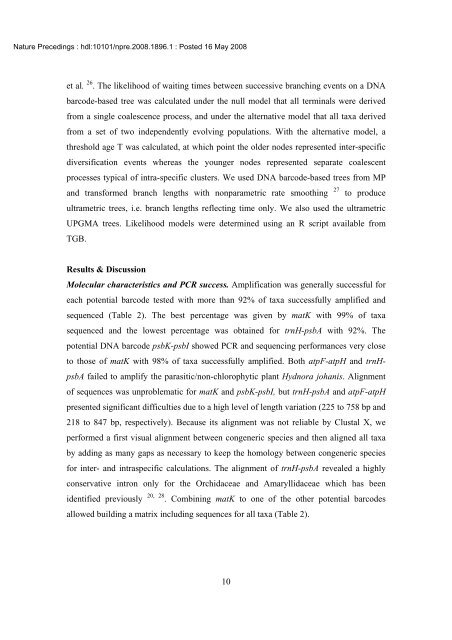pdf - A test of psbK-psbI and atpF-atpH as potential plant DNA - ArBOL
pdf - A test of psbK-psbI and atpF-atpH as potential plant DNA - ArBOL
pdf - A test of psbK-psbI and atpF-atpH as potential plant DNA - ArBOL
You also want an ePaper? Increase the reach of your titles
YUMPU automatically turns print PDFs into web optimized ePapers that Google loves.
Nature Precedings : hdl:10101/npre.2008.1896.1 : Posted 16 May 2008<br />
et al. 26 . The likelihood <strong>of</strong> waiting times between successive branching events on a <strong>DNA</strong><br />
barcode-b<strong>as</strong>ed tree w<strong>as</strong> calculated under the null model that all terminals were derived<br />
from a single coalescence process, <strong>and</strong> under the alternative model that all taxa derived<br />
from a set <strong>of</strong> two independently evolving populations. With the alternative model, a<br />
threshold age T w<strong>as</strong> calculated, at which point the older nodes represented inter-specific<br />
diversification events where<strong>as</strong> the younger nodes represented separate coalescent<br />
processes typical <strong>of</strong> intra-specific clusters. We used <strong>DNA</strong> barcode-b<strong>as</strong>ed trees from MP<br />
<strong>and</strong> transformed branch lengths with nonparametric rate smoothing 27 to produce<br />
ultrametric trees, i.e. branch lengths reflecting time only. We also used the ultrametric<br />
UPGMA trees. Likelihood models were determined using an R script available from<br />
TGB.<br />
Results & Discussion<br />
Molecular characteristics <strong>and</strong> PCR success. Amplification w<strong>as</strong> generally successful for<br />
each <strong>potential</strong> barcode <strong>test</strong>ed with more than 92% <strong>of</strong> taxa successfully amplified <strong>and</strong><br />
sequenced (Table 2). The best percentage w<strong>as</strong> given by matK with 99% <strong>of</strong> taxa<br />
sequenced <strong>and</strong> the lowest percentage w<strong>as</strong> obtained for trnH-psbA with 92%. The<br />
<strong>potential</strong> <strong>DNA</strong> barcode <strong>psbK</strong>-<strong>psbI</strong> showed PCR <strong>and</strong> sequencing performances very close<br />
to those <strong>of</strong> matK with 98% <strong>of</strong> taxa successfully amplified. Both <strong>atpF</strong>-<strong>atpH</strong> <strong>and</strong> trnHpsbA<br />
failed to amplify the par<strong>as</strong>itic/non-chlorophytic <strong>plant</strong> Hydnora johanis. Alignment<br />
<strong>of</strong> sequences w<strong>as</strong> unproblematic for matK <strong>and</strong> <strong>psbK</strong>-<strong>psbI</strong>, but trnH-psbA <strong>and</strong> <strong>atpF</strong>-<strong>atpH</strong><br />
presented significant difficulties due to a high level <strong>of</strong> length variation (225 to 758 bp <strong>and</strong><br />
218 to 847 bp, respectively). Because its alignment w<strong>as</strong> not reliable by Clustal X, we<br />
performed a first visual alignment between congeneric species <strong>and</strong> then aligned all taxa<br />
by adding <strong>as</strong> many gaps <strong>as</strong> necessary to keep the homology between congeneric species<br />
for inter- <strong>and</strong> intr<strong>as</strong>pecific calculations. The alignment <strong>of</strong> trnH-psbA revealed a highly<br />
conservative intron only for the Orchidaceae <strong>and</strong> Amaryllidaceae which h<strong>as</strong> been<br />
identified previously 20, 28 . Combining matK to one <strong>of</strong> the other <strong>potential</strong> barcodes<br />
allowed building a matrix including sequences for all taxa (Table 2).<br />
10


